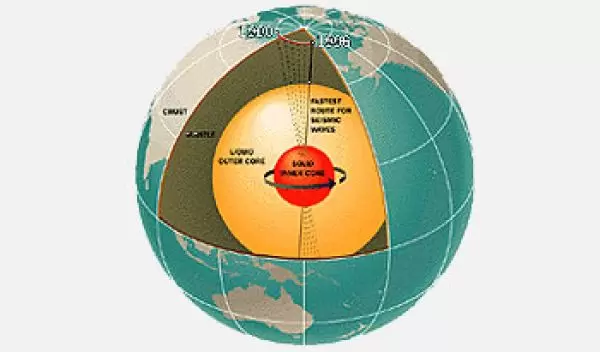
Earth's Core Spins Faster than Earth
The world turns. And deep within our planet, the Earth's inner core also turns -- only it's spinning faster than the surface. Every 400 years or so, it overtakes those of us riding on the outside.
The motion of the inner core had never been detected or measured before this startling discovery was made in 1996 by two NSF-funded seismologists working at the Lamont-Doherty Earth Observatory at Columbia University. They took on the challenge of investigating an unproven theory that states that the inner core rotates separately from the rest of the planet, as predicted by an unproven model of the Earth's magnetic field.
Using seismic wave readings from 38 earthquakes between 1967 and 1995, researchers Xiaodong Song, now at the University of Illinois, Urbana-Champaign, and Paul Richards tracked waves that moved from the south Atlantic, through the inner core, to College, Alaska. They found that the waves in the 1990s were 0.3 seconds faster than those in the 1960s. In human terms, this change may seem negligible, but by geological standards it means that the inner core is a fast mover.
The discovery indicates that the inner core -- a solid iron crystal whose mass is comparable to the size of the moon -- is spinning independently from the rest of the solid Earth. It is driven by magnetic and electrical effects within the near-frictionless liquid outer core that surrounds it.
The finding, reported in the journal Nature, will likely advance understanding of how the Earth's magnetic field is created and why it reverses periodically; how heat flows through the planet; and how the Earth's multi-layered interior has evolved.
"The inner core rotates in the same direction as the Earth but slightly faster," explained Jim Whitcomb of NSF's Earth Sciences division. "Over the past 100 years that extra speed has gained the core a quarter-turn on the planet as a whole. Such motion is remarkably fast for geological movements -- some 100,000 times faster than the drift of continents."
The discovery has sparked research to explain the pattern of changes in Earth's magnetic field, including the way the north and south poles have "wandered" and reversed periodically during Earth's history. It will yield new knowledge about temperatures at the center of the Earth, and the flow of planetary heat that ultimately drives the motions of tectonic plates at Earth's surface.
"For decades, the motion of the inner core has been the realm of theoreticians," says Paul Richards. "For the first time, we now have a hard piece of observational evidence, an actual measurement, of what's happening down there."
In addition to the 38 earthquakes that occurred between 1967 and 1995 near the South Sandwich Islands, the scientists also measured travel times of seismic waves to Norway from earthquakes in the Kermadec Islands near New Zealand. These waves took longer to travel through the inner core in the 1990s than they did in the 1980s. Song and Richards calculated that over a year, the inner core rotates about one longitudinal degree more than the Earth's mantle and crust, meaning the inner core makes a complete revolution inside the Earth in about 400 years.
The core was formed very early in Earth's history as heavier molten iron sank toward the center of the planet. As the planet cooled and dissipated its internal heat toward the surface, some molten iron began to solidify to create the dense, solid inner core. Enormous pressure keeps the inner core solid in a region with temperatures in the range of 7,000 degrees Fahrenheit and possibly much higher. Fluid iron in the outer core has continued to solidify at the boundary between the inner and outer cores, so that over a billion years, the inner core has grown steadily to its present diameter of 1,500 miles.
-- Cheryl Dybas


